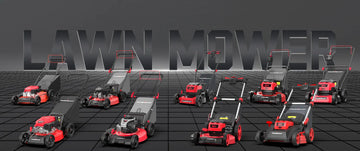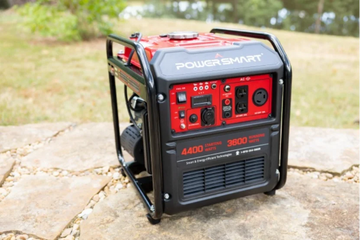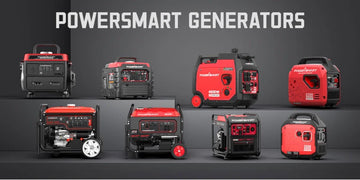Types of Lawn Mowers: How to Choose the Right One for Your Lawn
by lin ying on Jul 08, 2024

Manual Mowers
Reel Mowers
Features and Specifications
Reel mowers, also known as manual push mowers, are traditionally designed with a set of rotating blades that cut grass in a scissor-like motion. They typically feature 4 to 7 blades, and their cutting action helps promote a healthier lawn by making clean cuts. These mowers are lightweight and easy to maneuver, making them ideal for small to medium-sized lawns. Reel mowers operate quietly, do not require fuel or electricity, and have minimal maintenance needs, comprised mostly of occasional blade sharpening. They are generally constructed of durable materials, ensuring longevity and reliability.
Ideal Applications
Reel mowers are best suited for well-maintained lawns that do not feature overly thick or tall grass. They are excellent for those who prioritize eco-friendly lawn care solutions and have relatively small areas to manage. Ideal for urban settings with limited lawn space, reel mowers offer an effective solution for homeowners who value simplicity and sustainability. They are also beneficial for those who prefer a more active approach to lawn maintenance, enjoying the physical activity involved in pushing the mower.
Electric Lawn Mowers
Corded Electric Mowers

Features and Usage
Corded electric mowers utilize an electric motor powered by a direct connection to an electrical outlet. These mowers are renowned for their consistent power output, providing reliable performance as long as they remain plugged in. They typically feature a range of cutting widths and adjustable height settings to accommodate various lawn conditions. Using a corded electric mower is straightforward; simply plug it in, ensure the cord is clear of the cutting path, and begin mowing. This type of mower eliminates the need for gasoline, thereby reducing operational costs and environmental impact.
Pros and Cons
Corded electric mowers offer several advantages, including lower noise levels, reduced carbon emissions, and continuous power supply without the need for recharging. They are generally lighter than gas mowers and require less maintenance. However, they also come with certain drawbacks; the primary limitation being the necessity of staying connected to a power source, which can restrict movement and limit the area of use. Additionally, navigating around the cord can be cumbersome, raising the risk of accidentally cutting the power line.
Cordless (Battery-Powered) Electric Mowers

Features and Usage
Cordless electric mowers, powered by rechargeable batteries, offer similar benefits to their corded counterparts but with greater flexibility. Without the constraint of a power cord, these mowers are highly maneuverable, allowing for unrestricted movement throughout the yard. Features often include varying cutting widths and adjustable blade heights to suit different grass types and growth patterns. Using a cordless electric mower is convenient; charge the battery, insert it into the mower, and start mowing without the hassle of a power cord.
Charging and Battery Life
The efficiency of a cordless electric mower largely depends on its battery life and charging capabilities. Modern models typically feature lithium-ion batteries, known for their longer lifespan and quicker charging times compared to older battery types. Depending on the mower and battery model, users can expect between 30 to 90 minutes of run time on a full charge. Many cordless mowers come with dual-battery systems to extend operational time and ensure users can complete their mowing tasks without interruptions. Charging times can range from 30 minutes to several hours, and having spare batteries on hand can facilitate uninterrupted mowing sessions.
Gas-Powered Lawn Mowers

Push Gas Mowers
Features and Efficiency
Push gas mowers are traditional lawn mowers powered by gasoline engines, providing robust power suitable for various lawn conditions, including thick and tall grass. These mowers feature adjustable cutting heights and multiple blade options for diverse mowing needs. Push gas mowers are known for their durability and ability to cover larger areas quickly. They are equipped with sizable fuel tanks to ensure extended operation before requiring refueling. The power generated by the gas engine facilitates efficient cutting, even under challenging conditions, making push gas mowers a reliable choice for many homeowners.
Environmental Considerations
While push gas mowers offer powerful performance, they also come with environmental drawbacks. These mowers emit carbon dioxide and other pollutants, contributing to air pollution and greenhouse gas emissions. The noise levels produced by gas engines are significantly higher compared to electric mowers, potentially disturbing quiet neighborhoods. Regular maintenance, such as changing the oil, replacing spark plugs, and ensuring proper fuel mixture, is essential to maintain optimal performance and minimize environmental impact. For eco-conscious homeowners, considering mowers with lower emissions or switching to electric models might be advisable.
Self-Propelled Gas Mowers
Features and Ease of Use
Self-propelled gas mowers are equipped with a drive system that propels the mower forward, reducing the physical effort required by the user. This feature is particularly beneficial for those with larger lawns or hilly terrain, as it significantly eases the burden of mowing. These mowers come with adjustable speed settings, allowing users to match the pace of the mower to their walking speed or lawn conditions. Typically, self-propelled gas mowers feature robust engines and durable construction, ensuring they can handle various lawn types and conditions with ease.
Maintenance Tips
Maintaining a self-propelled gas mower involves regular servicing to ensure continued efficient performance. Key maintenance tasks include changing the oil, cleaning or replacing the air filter, sharpening or replacing blades, and checking the drive system for any issues. Additionally, it is essential to keep the undercarriage and cutting deck clean to prevent grass buildup, which can impede performance. Periodically inspect all components, such as cables and belts, for wear and tear, replacing them as needed to prevent breakdowns during mowing.
Riding Lawn Mowers
Standard Riding Mowers
Features and Terrain Suitability
Standard riding mowers, often referred to as lawn tractors, are designed for efficient mowing of large areas with minimal physical exertion. They come with a comfortable seat and straightforward controls, allowing the user to sit and drive across the lawn while mowing. Standard riding mowers are equipped with powerful engines and wide cutting decks, enabling them to handle various terrains, including slight hills and uneven surfaces. They feature multiple cutting height adjustments and attachments, such as baggers and mulchers, to enhance their versatility.
Cost Considerations
While standard riding mowers offer convenience and efficiency, they also come with a higher initial cost compared to push and self-propelled mowers. The price can vary significantly based on features, engine power, and brand reputation. Additionally, operating costs, including fuel, maintenance, and potential repairs, should be considered when assessing the overall investment. However, the time and effort saved by using a riding mower for large lawns often justify the higher cost, especially for those with extensive properties to maintain.
Zero-Turn Radius (ZTR) Mowers
Functionality and Control
Zero-turn radius (ZTR) mowers are designed with a unique steering mechanism that allows them to pivot 180 degrees on the spot, providing exceptional maneuverability and control. This feature is particularly advantageous for navigating around obstacles such as trees, flower beds, and lawn ornaments. ZTR mowers typically come with dual hydrostatic transmissions, allowing for smooth and precise handling. They are equipped with powerful engines and wide cutting decks, making them ideal for efficiently mowing large areas with intricate landscapes.
Best Use-Cases
ZTR mowers are best suited for vast lawns and properties with numerous obstacles requiring frequent turning and maneuvering. Their agility and speed make them the preferred choice for professional landscapers and homeowners with sizable or complex yard layouts. While they can handle various terrain types, ZTR mowers perform best on flat to moderately sloped surfaces. Investing in a ZTR mower ensures significant time savings and a professionally manicured lawn appearance, even in challenging mowing scenarios.
Robotic Lawn Mowers

Technology and Automation
Robotic lawn mowers represent the pinnacle of modern lawn care, leveraging advanced technology and automation to maintain a perfectly manicured lawn with minimal user intervention. These mowers operate autonomously, navigating the lawn using a combination of sensors and boundary wires to avoid obstacles and ensure thorough coverage. Equipped with adjustable cutting heights and multiple programming options, robotic mowers can be tailored to meet the specific needs of different lawns. Users can control and monitor these mowers remotely via smartphone apps, offering unparalleled convenience and efficiency.
Installation and Boundaries
Setting up a robotic lawn mower involves several steps to ensure optimal performance. First, the boundary wire must be laid out along the edge of the lawn and around any obstacles to define the mowing area. This wire creates an invisible fence that the mower's sensors detect, preventing it from leaving the designated area. Installation also includes programming the mower's schedule and cutting settings based on the lawn's size, shape, and grass type. While the initial setup may require some effort, the long-term benefits of an automated mowing system are substantial.
Maintenance Needs
Robotic lawn mowers are designed for low-maintenance operation but still require periodic care to ensure longevity and effective performance. Regular tasks include cleaning the mower's blades and sensors, checking and replacing the cutting blades as needed, and keeping the boundary wire in good condition. Seasonal maintenance may involve software updates and battery checks to maintain optimal functionality. By adhering to routine maintenance schedules, users can prolong the life of their robotic mowers and ensure consistent, high-quality lawn care.
Mulching vs. Bagging vs. Side Discharge
Mulching Benefits
Mulching involves finely chopping grass clippings and returning them to the lawn's surface, providing a natural fertilizer that promotes healthy grass growth. This process helps retain moisture, reduce thatch buildup, and enrich the soil with essential nutrients. Mulching mowers feature specialized blades and decks designed to chop clippings efficiently, making them an excellent choice for maintaining a lush, green lawn without the need for additional fertilizers. Moreover, mulching eliminates the need to dispose of grass clippings, saving time and effort.
Bagging Process
Bagging involves collecting grass clippings in an attached bag during the mowing process. This method provides a clean lawn appearance, free of clippings and debris. Bagging is particularly beneficial for lawns with weed problems, as it helps prevent the spread of weed seeds. However, it requires more effort to empty and dispose of the collected clippings regularly. Bagging mowers are ideal for homeowners who prefer a pristine lawn or need to remove clippings for composting or municipal disposal.
Side Discharge Convenience
Side discharge mowers expel grass clippings to the side, distributing them evenly across the lawn. This method is convenient for quickly mowing larger areas without the need to stop and empty a bag. Side discharge is suitable for handling overgrown grass, as it prevents clogging and allows for continuous mowing. However, it may leave clippings scattered on the lawn, requiring additional cleanup for a neater appearance. Side discharge mowers are ideal for fast, efficient mowing in less manicured settings.
Key Factors to Consider when Selecting a Lawn Mower
When choosing a lawn mower, several key factors should be considered to ensure the best fit for your lawn and preferences. First, assess the size of your lawn, as larger areas may benefit from a riding or self-propelled mower, while smaller lawns can be efficiently maintained with a manual or electric mower. Terrain type is also crucial; hilly or uneven lawns may require more powerful mowers with advanced maneuverability features. Consider the mower's power source—gas, electric, or battery-powered—based on your environmental concerns and convenience needs. Additionally, evaluate maintenance requirements, cost, and any specific features, such as mulching capabilities or automated operation, to select the most suitable mower for your lawn care routine.
Final Thoughts on Choosing the Right Lawn Mower
Selecting the right lawn mower is essential for maintaining a healthy, attractive lawn while optimizing time and effort. By understanding the various types of lawn mowers and their respective features, benefits, and limitations, you can make an informed decision that aligns with your lawn's specific needs and your personal preferences. Whether you prioritize environmental sustainability, ease of use, or advanced technology, there is a lawn mower designed to meet your requirements. Investing in the appropriate lawn mower will not only enhance the health and appearance of your lawn but also provide a more enjoyable and efficient lawn care experience.
If you are planning to purchase a Lawn Mower, PowerSmart can give you a variety of choices.
PowerSmart Lawn Mowers are known for their powerful performance, durability, and ease of use. These mowers are equipped with high-performance engines and ergonomic designs, ensuring a perfect cut every time. They also offer adjustable cutting heights to meet your specific lawn care needs.
PowerSmart offers a variety of models to choose from, including push mowers, self-propelled mowers, and eco-friendly options. The eco-friendly models are ideal for budget-conscious consumers who are looking for lightweight and easy-to-use mowers for basic lawn maintenance.
PowerSmart, headquartered in Itasca, Illinois, has been specializing in the design and manufacture of outdoor power equipment since the 1990s. Their product range includes lawn mowers, generators, snow blowers, yard cleanup tools, and more. They are dedicated to providing high-quality products and dependable customer service at the lowest possible price.
Overall, PowerSmart Lawn Mowers are favored by gardening enthusiasts for their performance, durability, and user-friendly features.




